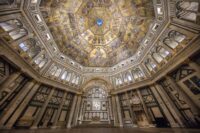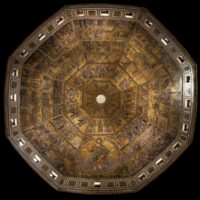 After five years of restoration, the eight internal walls of the Baptistery of Florence adorned with three different colors of marble inlay and magnificent mosaics have been liberated from scaffolding and can be seen again in all their newly-revived glory.
After five years of restoration, the eight internal walls of the Baptistery of Florence adorned with three different colors of marble inlay and magnificent mosaics have been liberated from scaffolding and can be seen again in all their newly-revived glory.
The Opera di Santa Maria del Fiore, the governing body that administers Florence’s cathedral complex which includes both the Duomo and the Baptistery, began a comprehensive restoration of the internal walls of the Baptistery at the end of 2017 following repairs to the external walls and roof. The project was enormously complex. There are 12,000 square feet of marble inlay surfaces, more than 2,000 square feet of mosaics and more than 1,000 square feet of gold leaf.
The parietal mosaics were created in the 14th century as extensions of the motifs and pictorial style of the exceptional mosaics applied to the interior of the dome, which was still ongoing when work began on the apse.
The mosaics of the scarsella [the apse] differ from the parietal ones both in the narrative complexity and for the execution technique. In fact, in these mosaics, extremely minute tesserae were used and an extraordinary chromatic variety of glass pastes and other precious materials including coral – which to date does not appear to have been used elsewhere in mosaic art – branches or in cross-sections that form microscopic circular or teardrop shaped tesserae.
If the mosaics on the other seven internal facades of the Baptistery represent prophets, holy bishops and cherubs, those in the scarsella stage a rich iconographic program. In the vault the mirror images of the
Madonna and the Baptist seated on the throne are represented, flanked by four telamons that support the large central wheel. This is divided into eight spokes, occupied by solemn figures of biblical patriarchs and prophets who foretold the coming of Christ, symbolized in the lamb in the center of the wheel with an epigraph, which translated from Latin reads “Here is almighty God indicated by the meek lamb”. Other figures of prophets appear in the intrados of the triumphal arch, while on the external ring there are represented busts of Apostles, Evangelists and Saints flanking the Baptist in the center.
The vault and triumphal arch of the apse and the gallery of the matroneum were clad in marble originally, so when officials decided to install mosaics there too after the completion of the dome mosaics, Florence’s mosaicists had to invent a new technique to apply mosaics onto marble veneers. They used bespoke hollow terracotta tiles, each made to specific measurements, that were then cut and mounted to the marble walls with iron linchpins. Even the mortar was completely customized, closer to an adhesive than a traditional mastic.
The unique approach and materials posed an enormous challenge to conservators. The team started by collecting data, performing the first diagnostic analyses of the parietal mosaics ever done. They found evidence of the original techniques used to install the mosaics, questionable later repairs and materials like traces of gold leaf on one of the column capitals that suggests all of the capitals were originally gilded.
 The restoration was repeatedly interrupted and delayed by the pandemic and ultimately cost 2.6 million euros, but that hasn’t deterred the Opera from moving forward with an even more complex project: the restoration of the mosaics on the Baptistery’s octagonal dome. They have designed a new restoration scaffold system of horizontal platforms supported by a central column. This will allow restorers to shift upwards as they focus on new surfaces while still keeping the dome visible from the ground.
The restoration was repeatedly interrupted and delayed by the pandemic and ultimately cost 2.6 million euros, but that hasn’t deterred the Opera from moving forward with an even more complex project: the restoration of the mosaics on the Baptistery’s octagonal dome. They have designed a new restoration scaffold system of horizontal platforms supported by a central column. This will allow restorers to shift upwards as they focus on new surfaces while still keeping the dome visible from the ground.